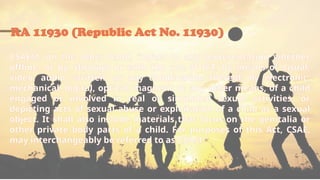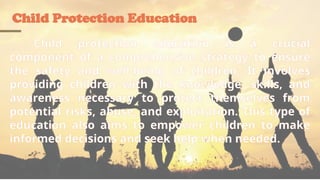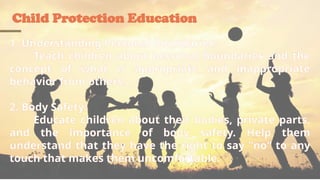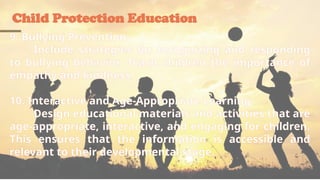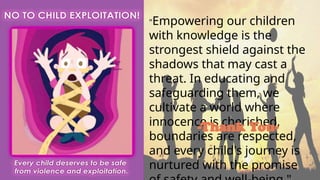Child Protection Policy Powerpoint for In-Service Training
- 1. CHILD PROTECTION POLICY (CHILD SEXUAL ABUSE)
- 2. OBJECTIVES: 1. Identify the various offline and online child protection concerns that learners might encounter. 2. Identify the various means these child protection concerns might be perpetrated. 3. Identify the various means of integrating Child Protection into their lessons. 4. Distinguish what DepEd policy and protocol should be applied for specific child protection concerns. 5. Be introduced to the various initiatives of DepEd in relation to child protection.
- 3. Define a Child? The United Nations Convention on the Rights of the Child (UNCRC) defines a child as everyone under 18 unless, "under the law applicable to the child, majority is attained earlier"
- 4. CHILDRENâS RIGHT The United Nations Convention on the Rights of the Child is an important agreement by countries who have promised to protect childrenâs rights. The Convention explains who children are, all their rights, and the responsibilities of governments. All the rights are connected, they are all equally important and they cannot be taken away from children.
- 6. RIGHTS OF A FILIPINO CHILD 1 âĒ Every child has the right to be born well. 2 âĒ Every child has the right to a wholesome family life. 3 âĒ Every child has the right to be raised well and become contributing members of society. 4 âĒ Every child has the right to basic needs. 5 âĒ Every child has the right to access what they need to have a good life. 6 âĒ Every child has the right to education.
- 7. RIGHTS OF A FILIPINO CHILD 7 âĒ Every child has the right to play and enjoy their youth. 8 âĒ Every child has the right to be protected from danger. 9 âĒ Every child has the right to live in a productive environment. 10 âĒ Every child has the right to be cared for in the absence of their parent or guardian. 11 âĒ Every child has the right to good governance 12 âĒ Every child has the right to freedom and peace.
- 8. I Am a Child Course 1 (NEAP): Are You Ready? | Stairway Founda tion Inc.
- 9. I Am a Child
- 10. Alligator River Story - (stairwayfoundation.org)
- 11. What is Child Sexual Abuse? Course 1 (NEAP): What is Child Sexual Abu se? | Stairway Foundation Inc. Course 1 (NEAP): Protecting Children | S tairway Foundation Inc. Protecting Children
- 12. Daughter
- 13. What is Situational Sex Offender? Who can be a victim of child sexual abuse within the family? Course 1 (NEAP): What is a Situational Child Sex Offender? | Stairway Foundation Inc. Course 1 (NEAP): Who Can be a Victim of Child Sexual Abuse Within the Family? | Stairway Foundation Inc.
- 14. What is a Preferential Sex Offender? Course 2 (NEAP): What is a Preferential Child Sex Offender? | Stairway Foundation Inc.
- 15. A Good Boy
- 16. What is Child Sex Trafficking? Course 2 (NEAP): What is Child Sex Trafficking? | Stairway Foundation Inc.
- 17. Child Online Protection Concerns Child online protection is a critical issue in today's digital age, as children increasingly use the internet for various purposes, including education, entertainment, and socialization. There are several concerns related to the online safety of children:
- 18. Child Online Protection Concerns ï Inappropriate Content ï Online Predators ï Cyberbullying ï Privacy Concerns ï Addiction and Screen Time ï Online Gaming Risks
- 19. Digital Literacy Digital literacy plays a crucial role in child protection policies, as it empowers both children and adults to navigate the digital landscape safely and responsibly. Incorporating digital literacy into child protection policies helps create a comprehensive approach to addressing online risks and promoting a secure online environment for children. Here are ways in which digital literacy is integrated into child protection policies:
- 20. Digital Literacy integrated into Child Protection Policies 1. Educational Programs: ï Curriculum Integration: Child protection policies may include the integration of digital literacy education into school curricula. This can cover topics such as online safety, responsible internet use, and critical evaluation of online content.
- 21. Digital Literacy integrated into Child Protection Policies 2. Parental Guidance and Support: ï Parental Education: Policies may advocate for initiatives that educate parents and caregivers about digital literacy, helping them understand the online risks their children may face and providing guidance on how to support safe online practices.
- 22. Digital Literacy integrated into Child Protection Policies 3. Online Safety Training: ï Training for Children: Child protection policies may emphasize the importance of providing children with specific training on online safety, including guidance on privacy settings, recognizing potential risks, and dealing with cyberbullying.
- 23. Digital Literacy integrated into Child Protection Policies 4. Collaboration with Stakeholders: ï Partnerships with Schools and NGOs: Child protection policies may encourage collaboration with schools, non-governmental organizations (NGOs), and other stakeholders to implement digital literacy programs that extend beyond the classroom.
- 24. Digital Literacy integrated into Child Protection Policies 5. Protection Against Online Predators: ï Awareness and Prevention: Policies may include strategies for raising awareness about online predators and providing children with the skills to identify and avoid potential threats.
- 25. Digital Literacy integrated into Child Protection Policies 6. Addressing Cyberbullying: ï Educational Initiatives: Child protection policies may focus on educating children about the harmful effects of cyberbullying, promoting positive online behavior, and providing resources for addressing and reporting incidents.
- 26. Digital Literacy integrated into Child Protection Policies 7. Privacy and Security Measures: ï Guidance on Privacy Settings: Policies may offer guidelines on configuring privacy settings on various platforms and devices to help children protect their personal information.
- 27. Digital Literacy integrated into Child Protection Policies 8. Monitoring and Reporting Mechanisms: ï Encouraging Reporting: Child protection policies may establish reporting mechanisms for children to report inappropriate online behavior or incidents, creating a supportive environment for disclosure.
- 28. Digital Literacy integrated into Child Protection Policies 9. Policy Implementation in Educational Institutions: ï Guidelines for Schools: Child protection policies may provide guidelines for schools on implementing digital literacy initiatives, ensuring that educational institutions are proactive in addressing online safety concerns.
- 29. Digital Literacy integrated into Child Protection Policies 10. Continuous Updates and Adaptation: ï Keeping Pace with Technology: Child protection policies should emphasize the need for continuous updates to digital literacy programs to address emerging online risks and new technologies.
- 30. The various DepEd Policies and Protocols on Child Protection
- 31. DepEd Child Protection Policy (DepEd Order No. 40, s. 2012): This policy outlines the guidelines and procedures for the protection of children in the school setting. It emphasizes the creation of a Child Protection Committee in schools and the designation of a Child Protection focal person.
- 32. Anti-Bullying Policies (DepEd Order No. 55, s. 2013): This policy addresses bullying in schools and provides guidelines for the prevention and management of bullying incidents. It includes the establishment of a Child Protection Committee and the conduct of awareness programs on anti-bullying.
- 33. Child Protection Committees (DepEd Order No. 55, s. 2013) Schools are required to form Child Protection Committees, composed of school personnel, parents, and other stakeholders. These committees are responsible for ensuring the implementation of child protection policies and responding to child protection concerns.
- 34. Gender-Fair Education (DepEd Order No. 32, s. 2013): This policy promotes gender sensitivity and equality in education, ensuring that schools provide a safe and inclusive environment for all students.
- 35. Guidelines on the Protection of Children in Armed Conflict (DepEd Order No. 50, s. 2011): These guidelines aim to protect children in situations of armed conflict, including the establishment of child-friendly spaces in schools.
- 36. Guidelines on the Protection of Children during Emergencies and Disasters (DepEd Order No. 93, s. 2011): This policy provides guidelines for ensuring the safety and well-being of children during emergencies and disasters.
- 37. Inclusive Education Policy (DepEd Order No. 72, s. 2009): The Inclusive Education Policy promotes the rights of children with special needs, ensuring that they receive equitable access to quality education.
- 38. RA 11930 (Republic Act No. 11930) Anti-Online Sexual Abuse of Exploitation of Children and Anti-Child Sexual Abuse or Exploitation Materials Act
- 39. RA 11930 (Republic Act No. 11930) The Act is primarily a penal law seeking to punish the online sexual abuse or exploitation of children (OSAEC). OSAEC is defined as âthe use of ICT as a means to abuse and/or exploit children sexually, which includes cases in which offline child abuse and/or exploitation is combined with an online component. This can also include, but is not limited to the production, dissemination and possession of [child sexual abuse or exploitation material or child sexual abuse material] CSAEM; online grooming of children for sexual purposes; sexual extortion of children, sharing image-based sexual abuse; commercial sexual exploitation of children; exploitation of children through online prostitution; and live-streaming of sexual abuse, with or without the consent of the victim: Provided, That OSAEC may be used interchangeably with online child sexual abuse exploitation or abuse (OCSEA).â
- 40. RA 11930 (Republic Act No. 11930) CSAEM, on the other hand, ârefers to any representation whether offline, or by, through or with the use of ICT, by means of visual, video, audio, written, or any combination thereof, by electronic, mechanical, digital, optical, magnetic or any other means, of a child engaged or involved in real or simulated sexual activities, or depicting acts of sexual abuse or exploitation of a child as a sexual object. It shall also include materials that focus on the genitalia or other private body parts of a child. For purposes of this Act, CSAE, may interchangeably be referred to as CSAM.â
- 41. Child Protection Education Child protection education is a crucial component of a comprehensive strategy to ensure the safety and well-being of children. It involves providing children with the knowledge, skills, and awareness necessary to protect themselves from potential risks, abuse, and exploitation. This type of education also aims to empower children to make informed decisions and seek help when needed.
- 42. Child Protection Education 1. Understanding Personal Boundaries: Teach children about personal boundaries and the concept of what is appropriate and inappropriate behavior from others. 2. Body Safety: Educate children about their bodies, private parts, and the importance of body safety. Help them understand that they have the right to say "no" to any touch that makes them uncomfortable.
- 43. Child Protection Education 3. Recognizing and Reporting Abuse: Provide information on different forms of abuse, including physical, emotional, and sexual abuse. Teach children how to recognize signs of abuse and empower them to report it to a trusted adult. 4. Online Safety: Address the importance of online safety, including guidelines for using the internet responsibly, recognizing online risks, and understanding the potential dangers of sharing personal information
- 44. Child Protection Education 5. Building Self-Esteem: Promote self-esteem and self-confidence in children, as these qualities can empower them to assert themselves and resist negative influences. 6. Understanding Consent: Educate children about the concept of consent, emphasizing that they have the right to say "yes" or "no" to any activity or touch. Teach them to respect others' boundaries as well.
- 45. Child Protection Education 7. Effective Communication: Develop communication skills in children to encourage open and honest conversations. Help them understand the importance of expressing their feelings and concerns. 8. Safe Adults and Reporting Mechanisms: Identify and discuss who safe adults are in a child's life. Teach children about reporting mechanisms, including how and where to seek help if they feel unsafe.
- 46. Child Protection Education 9. Bullying Prevention: Include strategies for recognizing and responding to bullying behavior. Teach children the importance of empathy and kindness. 10. Interactive and Age-Appropriate Learning: Design educational materials and activities that are age-appropriate, interactive, and engaging for children. This ensures that the information is accessible and relevant to their developmental stage.
- 47. Child Protection Education 11. Crisis Response: Educate children on what to do in emergency situations, including who to contact and where to seek help. 12. Involvement of Parents and Caregivers: Engage parents and caregivers in child protection education. Provide resources and information to help them reinforce the lessons at home.
- 48. "Empowering our children with knowledge is the strongest shield against the shadows that may cast a threat. In educating and safeguarding them, we cultivate a world where innocence is cherished, boundaries are respected, and every child's journey is nurtured with the promise -Thank You-

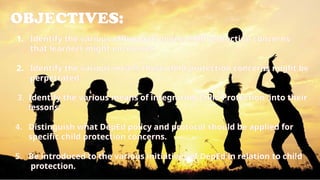
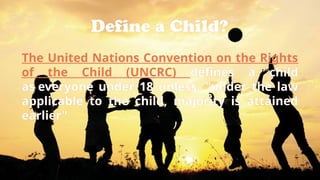
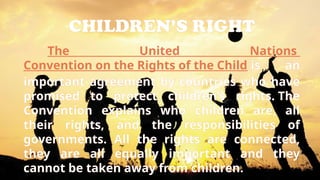
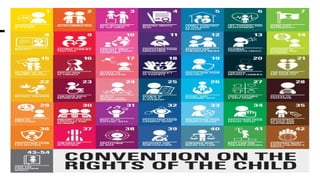
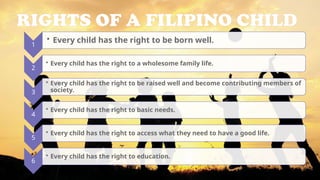
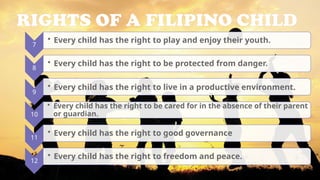
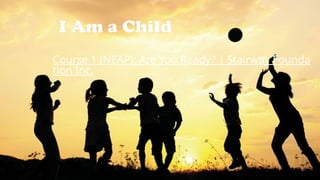
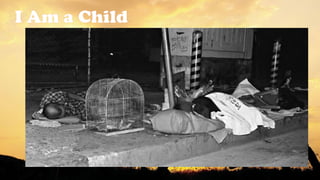
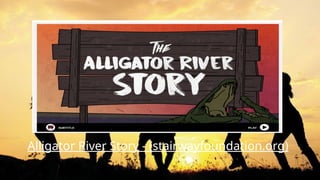
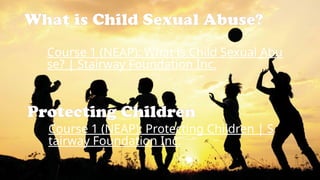

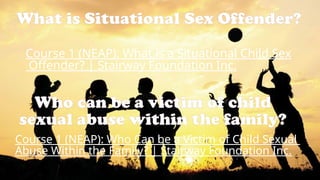
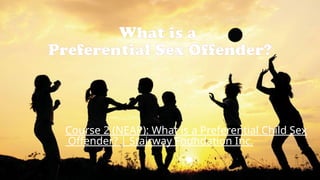

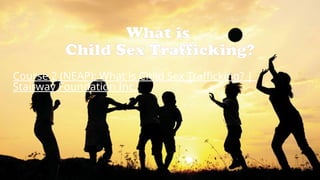
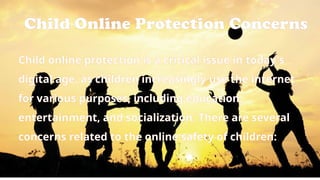
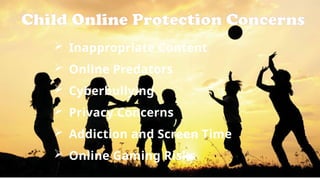
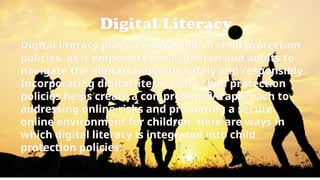
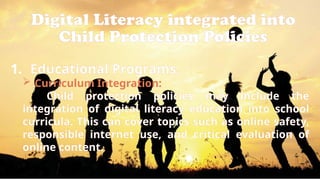
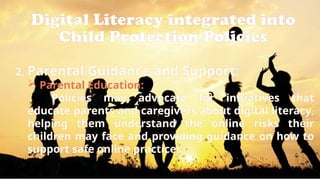
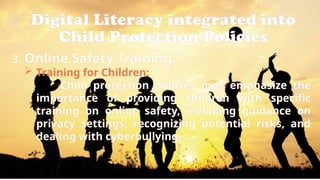
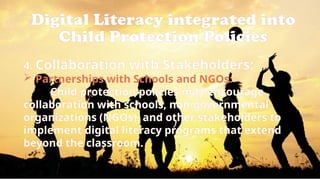
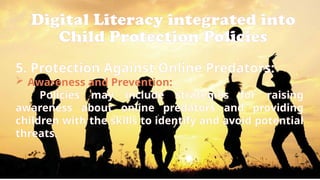
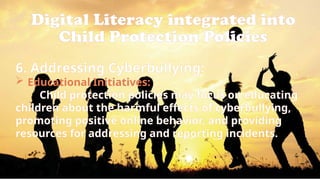
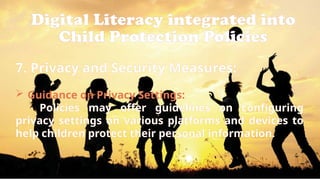
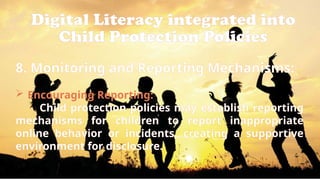

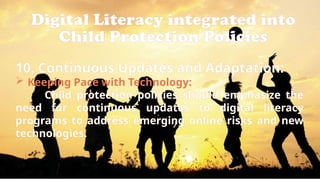
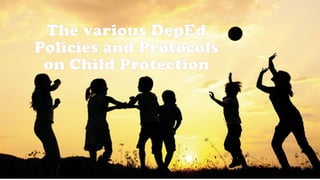
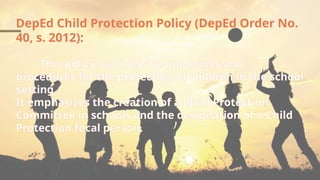
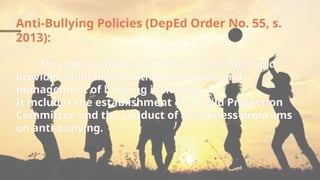
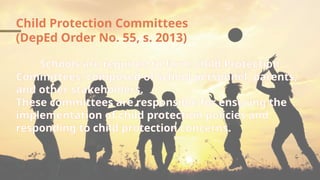
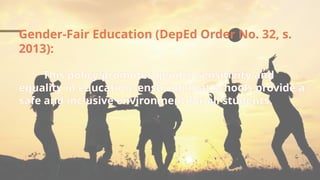
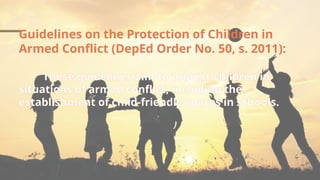
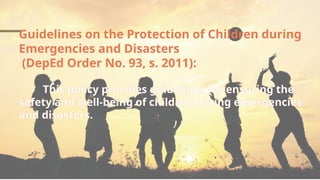
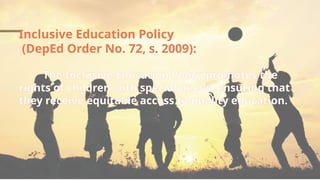
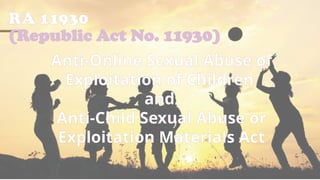
![RA 11930 (Republic Act No. 11930)
The Act is primarily a penal law seeking to punish the online sexual
abuse or exploitation of children (OSAEC). OSAEC is defined as âthe
use of ICT as a means to abuse and/or exploit children sexually,
which includes cases in which offline child abuse and/or exploitation
is combined with an online component. This can also include, but is
not limited to the production, dissemination and possession of [child
sexual abuse or exploitation material or child sexual abuse material]
CSAEM; online grooming of children for sexual purposes; sexual
extortion of children, sharing image-based sexual abuse; commercial
sexual exploitation of children; exploitation of children through
online prostitution; and live-streaming of sexual abuse, with or
without the consent of the victim: Provided, That OSAEC may be used
interchangeably with online child sexual abuse exploitation or abuse
(OCSEA).â](https://image.slidesharecdn.com/cpp-241124141048-ec67c7c1/85/Child-Protection-Policy-Powerpoint-for-In-Service-Training-39-320.jpg)
